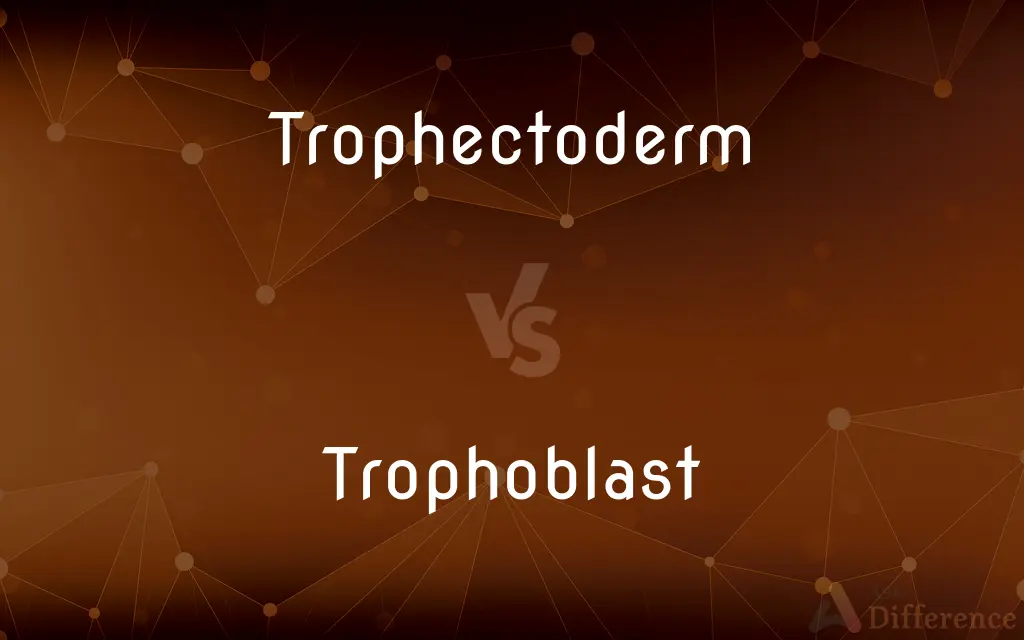Trophectoderm vs. Trophoblast — What's the Difference?
By Tayyaba Rehman & Maham Liaqat — Updated on April 24, 2024
Trophectoderm forms the outer cell layer in early embryos, contributing to placenta formation, while trophoblast includes these cells and others involved in nutrient exchange.

Difference Between Trophectoderm and Trophoblast
Table of Contents
ADVERTISEMENT
Key Differences
The trophectoderm is the initial layer of cells found in the blastocyst during early embryonic development, responsible primarily for initiating contact with the uterine wall. On the other hand, the trophoblast evolves from the trophectoderm and expands its role to include forming the placenta and facilitating nutrient uptake.
While the trophectoderm exclusively encompasses the cells that line the outer shell of the blastocyst, the trophoblast extends to include additional cells that develop later, like the cytotrophoblast and syncytiotrophoblast, which play crucial roles in embedding the embryo into the uterine lining.
In terms of function, the trophectoderm primarily facilitates the implantation of the embryo by forming the initial interface with the maternal endometrium. Conversely, the trophoblast, which develops from the trophectoderm, not only aids in implantation but also in the establishment of nutrient and gas exchange between the mother and the fetus.
The trophectoderm is also critical for the structural integrity of the early embryo, maintaining the blastocyst's shape and form. Whereas the trophoblast contributes to forming the chorionic villi, structures essential for fetal-maternal blood exchange during pregnancy.
The identification and study of the trophectoderm are crucial in assisted reproductive technologies such as IVF, where it can be biopsied for genetic testing without harming the embryo. The trophoblast, by its development and function, is studied extensively in the context of pregnancy health and pathologies, such as preeclampsia.
ADVERTISEMENT
Comparison Chart
Definition
Outer layer of cells in the blastocyst
Layer derived from the trophectoderm
Role in Embryo
Initiates implantation; maintains shape
Forms placenta; facilitates nutrient exchange
Composition
Uniform layer of cells
Includes cytotrophoblast and syncytiotrophoblast
Key Functions
Contact with uterine wall
Nutrient and gas exchange, placenta formation
Importance in Medicine
Biopsied in IVF for genetic testing
Studied for pregnancy health and pathologies
Compare with Definitions
Trophectoderm
Involved in the early interactions between the embryo and the maternal environment.
The quality of the trophectoderm can influence the outcome of an IVF cycle.
Trophoblast
A cell layer that includes and develops from the trophectoderm, forming the placenta.
The trophoblast plays a key role in nutrient transfer from mother to fetus.
Trophectoderm
A layer of cells forming the outer ring of a blastocyst in early development.
The trophectoderm must remain intact for successful embryo implantation.
Trophoblast
Key in the development of the fetal portion of the placenta.
Abnormalities in trophoblast development can lead to pregnancy complications.
Trophectoderm
The first differentiated cells from the fertilized egg.
The trophectoderm differentiates by the blastocyst stage.
Trophoblast
Divides into the cytotrophoblast and syncytiotrophoblast.
The syncytiotrophoblast is crucial for embedding the embryo into the uterine wall.
Trophectoderm
Essential for maintaining the structure of the blastocyst.
Any damage to the trophectoderm can compromise the embryo’s viability.
Trophoblast
Involved in the exchange of gases and waste between mother and fetus.
The trophoblast’s functionality is critical for fetal development.
Trophectoderm
Can be safely biopsied for pre-implantation genetic testing.
Trophectoderm biopsy is a common procedure in genetic screening of embryos.
Trophoblast
Studied for its role in gestational diseases like preeclampsia.
Trophoblast dysfunction is often a precursor to preeclampsia.
Trophectoderm
(biology) The ectoderm from which the trophoblast develops.
Trophoblast
Trophoblasts (from Greek 'trephein': to feed; and 'blastos': germinator) are cells that form the outer layer of a blastocyst. They are present four days post-fertilization in humans.
Trophoblast
The outermost layer of cells of the mammalian blastocyst that attaches the fertilized ovum to the uterine wall and serves as a nutritive pathway for the embryo.
Trophoblast
(cytology) The membrane of cells that forms the wall of a blastocyst during early pregnancy, providing nutrients to the embryo and later developing into part of the placenta.
Trophoblast
The membrane that forms the wall of the blastocyst in early development; aids implantation in the uterine wall;
After implantation of the blastocyst in the uterine wall the trophoblast divides into two layers, the chorion and the placenta
Common Curiosities
What differentiates the trophectoderm from the trophoblast?
The trophectoderm is the initial outer cell layer in the blastocyst that later differentiates into the more complex trophoblast, which includes several types of cells and has broader functions including forming the placenta.
What is the primary function of the trophectoderm?
The primary function of the trophectoderm is to facilitate embryo implantation and maintain the blastocyst's structure.
How do abnormalities in the trophoblast affect pregnancy?
Abnormalities in the trophoblast can lead to serious pregnancy complications such as preeclampsia, intrauterine growth restriction, and placental abruption.
Is the trophectoderm present throughout pregnancy?
No, the trophectoderm is not present throughout pregnancy; it evolves into the trophoblast, which then participates actively in forming the placenta and supporting fetal development.
What are the components of the trophoblast?
The trophoblast comprises the cytotrophoblast, which are cells that retain their cell boundaries, and the syncytiotrophoblast, which is a multinucleated cell layer that forms through the fusion of cytotrophoblast cells.
What techniques are used to study the trophoblast?
Techniques such as ultrasound imaging, histological examination, and molecular biology methods are used to study the structure, function, and health of the trophoblast.
Can the health of the trophoblast predict pregnancy outcomes?
Yes, the health and functionality of the trophoblast are closely monitored as they can predict important pregnancy outcomes, including the risk of developing disorders like preeclampsia.
How is the trophectoderm important in assisted reproductive technologies?
In assisted reproductive technologies like IVF, the trophectoderm is crucial because it can be biopsied to perform genetic tests on the embryo without harming its developmental potential.
How is the trophoblast studied in medical research?
The trophoblast is extensively studied in medical research for its role in placenta formation and function, as well as its implications in pregnancy-related diseases and fetal-maternal health.
What role does the trophectoderm play in embryo implantation?
The trophectoderm plays a critical role in embryo implantation by facilitating the initial attachment of the blastocyst to the uterine wall, which is crucial for successful pregnancy establishment.
How does the function of the trophectoderm differ from that of the trophoblast in the early stages of pregnancy?
In the early stages of pregnancy, the trophectoderm is primarily involved in implantation and forming the initial contact with the maternal endometrium, whereas the trophoblast develops further to undertake complex functions such as nutrient and gas exchange and placenta formation.
Share Your Discovery

Previous Comparison
Ebullient vs. Exuberant
Next Comparison
Furbish vs. RefurbishAuthor Spotlight
Written by
Tayyaba RehmanTayyaba Rehman is a distinguished writer, currently serving as a primary contributor to askdifference.com. As a researcher in semantics and etymology, Tayyaba's passion for the complexity of languages and their distinctions has found a perfect home on the platform. Tayyaba delves into the intricacies of language, distinguishing between commonly confused words and phrases, thereby providing clarity for readers worldwide.
Co-written by
Maham Liaqat













































